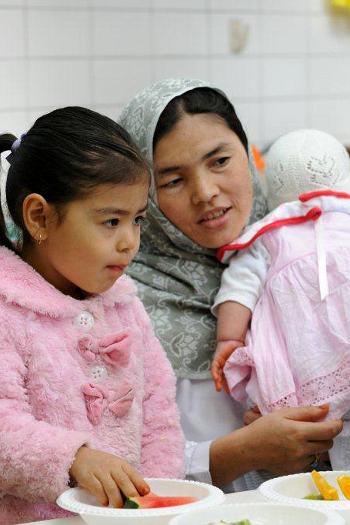Eating out
Duration/age

Eating out at a cafe or a restaurant is an opportunity to talk and sit together as a family.
You can explore all the different types of writing and print you can see around the restaurant. Do they have a menu on the table? Is there a long list on the wall that shows the food you can order? Where else can you see words and print?
The label on the water bottle has writing and words.
What do you think the words and numbers on the door say?
Talk with your child about the menu and the different sections in it. Are there pictures on the menu that help to explain what the words are saying?
Let’s start at the front of the menu. That’s where they list the small serves of food.
I want to eat pizza. I’m going to read the menu to see what kind of pizza they have.
Explain to your child that the food in the menu will be grouped. The food might be grouped by size of the serve, if it is vegetarian, has meat or is a certain type of food.
I feel like some chicken. I’ll have to find the section with the picture of the chicken to see what types they serve.
Materials you will need
- Restaurant
- Cafe
Alternative tools
- Fast food restaurant
Skills this activity improves
Why does this matter?
Reading and ordering food from the menu helps children to develop an understanding that print holds meaning.
Grouping items together identifies whether the serve is large or small, if the serve can be shared or if it is an extra to complement the main meal. This is the beginning of understanding that some things can be shared and divided.
Drawing attention to the cost of food helps children to understand that money helps us to make decisions on what we will buy and adding items will increase the cost.
What does this lead to?
Ordering food from the menu helps children to develop concepts of print and an understanding of how writing is ordered and grouped on a page. This is the beginning of reading. As they look at and explore the menu they are developing an understanding that pictures and images also hold meaning and add information to the writing.
Exploring the size of the serves and the cost of the meal is about measurement and understanding that we can describe the different attributes of an object by size, cost and capacity.
As you begin to talk about sharing serves or adding extras to items you are beginning to explore the process of addition and fractions.
Language to use
- Words, language, talking, pictures, symbols, list, menu
- Entree, main course, desert Large, small, medium, children’s serve
- Share, divide
- Pizza, vegetarian, meat, chicken, salad, ice-cream, pasta, fish, seafood, chips, bread
- Table, chair, counter, kitchen, door, entrance, toilet
- Order, pay, bill
- Waiter, waitress, customer, manager, chef, cook
Questions to use
- How many pieces of pizza can you eat?
- Is all pasta the same shape?
- Can you order ice-cream before you have soup?
- How is garlic bread different to a bread roll?
- How do you know how much to pay?
Useful tips
- If you are going to be at a restaurant for a long time, you could pack a bag of special things your child can do at the table.
- You might also like to take a look at the activities Ordering takeaway and Let's celebrate.
- To help decide where to eat with your child look through takeaway menus from the restaurant before you go. This will let them see what kind of food the different restaurants will serve.
- Remember to talk to your child in your home language.
Variation by age
Three to five year olds
- Set up a play restaurant at home.
- Find pictures of different foods in magazines to create your own restaurant.
- After eating at the restaurant, google what your child ordered and look for a recipe. Can you make it at home together?
Questions to ask
- What food will the restaurant serve?
- Where will the restaurant store the cold food?
- How do you make ice-cream?
- How do you make the pasta soft?
- Does a Japanese restaurant serve pizza?
Language to use
- Restaurant, menu, food
- Recipe, cooking, ordering
- Food category


